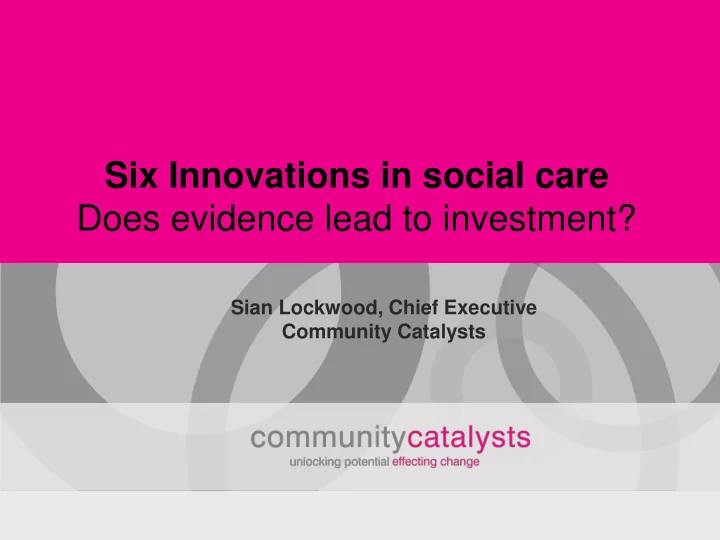

Six Innovations in social care Does evidence lead to investment? Sian Lockwood, Chief Executive Community Catalysts
The Six Innovations • Community-led home-care solutions • Community Circles • Local area co-ordination • Shared Lives • Homeshare • Wellbeing teams
Community-led homecare solutions Why? Traditional home-care services can struggle to reach everyone and provide the kind of service people need to live their life as they want How? A locally-embedded, skilled and knowledgeable Catalyst with Community Catalyst’s back up, helps local people understand what is needed and provides patient coaching and expert support so that enterprising solutions are sustainable, legal and high quality. Evidence? In rural Somerset over 3 years Community Catalysts has supported nearly 250 local enterprises, helping 800 people to stay at home and providing 3,500 hours of care a week. Customer survey by the council suggests small-scale local support delivers excellent outcomes. Direct annual savings to the council of over £400,000.
Community Circles Why? Many people are isolated and lonely, impacting on well-being and in some cases leading to frequent use of expensive services How? Community Connectors train volunteers facilitate Community Circles. They bring together family, friends, neighbours and professionals (sometimes) to support someone. Evidence? Limited as a comparatively new approach. PSSRU report (2014) on sample of Circles for people with learning disabilities showed significant reported increases in quality of life, increased community connections, reductions in carer stress.
Local area coordination Why? Much of current service provision focuses on people’s deficits or conditions. Often support is not available until the person is in crisis. Support available to people is not place-based. How? Well-connected contributing local people employed as local area co- ordinators. They provide an accessible point of contact locally and focus on people’s own visions for a good life beyond services. Help people build on their own assets and natural solutions. Evidence? International and national evidence show predictable outcomes and cost impact Eg Kingfishers (2016) Social value of local area coordination in Derby
Shared Lives Why? Regulated care and support for disabled and older people is variable and does not actively ehlp people and families to support andf build informal networks How? Local individuals and families are recruited and carefully assessed and approved by a regulated agency (a Shared Lives scheme). Someone (over 16) who needs long-term support is carefully matched with a Shared Lives family. Together they share family and community life. Evidence? Consistently outperforms all other forms of regulated care in CQC inspections. Independent report by Social Finance showed that Shared Lives delivers significant savings.
Homeshare Why? Many older people are lonely, isolated and finding it difficult to get the help they need to stay in their homes. Young people, students and people on low-wages struggle to find affordable accommodation. How? An agency carefully matches older householders with a room to spare with someone needing low-cost accommodation who will provide an agreed amount of low level support in return. Evidence? Key piece of research headed by SCIE will publish findings at the end of 2017
Wellbeing Teams Why? Care for older and disabled people at home is not working for many people. Poor care at home contributes to greater demand on hospitals and long term care How? Inspired by Buurtzorg. Small, neighbourhood self-managed teams to help people get the care they need to stay at home. Teams include Community Circle connectors. Evidence? Buurtzorg teams (community health focused) show excellent satisfaction rates for people and staff and low over-head costs by reducing layers of hierarchy and smart use of IT.
Background to the six innovations • Already working together or in the same places • Believe intentional collaboration will deliver added-value and make best use of scarce money • Intentional collaboration catalysed by John Bolton
So……………….
Does evidence lead to investment? • What ‘counts’ as evidence? o Community Catalysts in Somerset o Well-being teams • What types of evidence lead to investment? o Shared Lives o Local area coordination • What if there is no evidence? o Community Circles o Homeshare
Questions Sian Lockwood OBE Community Catalysts CIC sian.lockwood@communitycatalysts.co.uk
Recommend
More recommend